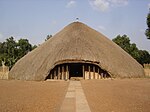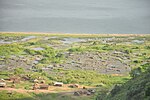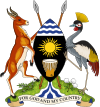List of World Heritage Sites in Uganda
The United Nations Educational, Scientific and Cultural Organization (UNESCO) World Heritage Sites are places of importance to cultural or natural heritage as described in the UNESCO World Heritage Convention, established in 1972.[1] Cultural heritage consists of monuments (such as architectural works, monumental sculptures, or inscriptions), groups of buildings, and sites (including archaeological sites). Natural features (consisting of physical and biological formations), geological and physiographical formations (including habitats of threatened species of animals and plants), and natural sites which are important from the point of view of science, conservation, or natural beauty, are defined as natural heritage.[2] Uganda accepted the convention on November 20, 1987, making its historical sites eligible for inclusion on the list.[3]
Uganda has three World Heritage Sites and a further five sites on its tentative list.[3] The first two sites were listed in 1994, both for their natural significance. The most recent site, the Tombs of Buganda Kings at Kasubi, was listed in 2001 due to cultural significance. Rwenzori Mountains National Park was listed as endangered from 1999 to 2004 because of security issues and lack of monitoring by the park staff.[4] The Kasubi Tombs were listed as endangered in 2010 because of a fire that destroyed several buildings[5] and removed from the endangered list in 2023 following a careful reconstruction.[6]
World Heritage Sites
UNESCO lists sites under ten criteria; each entry must meet at least one of the criteria. Criteria i through vi are cultural, and vii through x are natural.[7]
| Site | Image | Location (region) | Year listed | UNESCO data | Description |
|---|---|---|---|---|---|
| Bwindi Impenetrable National Park | 
|
Kanungu | 1994 | 682; ix, x (natural) | The park is located in the Albertine Rift. It is located at the intersection of three ecological zones and likely acted as a Pleistocene refugium. The area, covered by Albertine Rift montane forests, is a biodiversity hotspot, with over 100 species of ferns, over 200 species of montane forest butterflies, and 347 species of forest birds. It is also home to a significant population of the endangered mountain gorilla.[8] |
| Rwenzori Mountains National Park | 
|
Kasese | 1994 | 684; vii, x (natural) | The park is located in the Rwenzori Mountains, the legendary Mountains of the Moon. The mountains, with the highest peak Mount Stanley reaching an altitude of 5,109 m (16,762 ft) being Africa's third highest mountain, have glaciers, rivers, and waterfalls. High humidity, constant temperatures, and geographical isolation have contributed to evolution of the richest montane flora in Africa. There are five Afromontane vegetation belts on the mountain slopes, with plants such as giant lobelias and giant heathers. Animals in the park include African forest elephant, eastern chimpanzee, L'Hoest's monkey, and black-fronted duiker. The site was listed as endangered from 1999 to 2004 because of security issues and lack of monitoring by the park staff.[4][9] |
| Tombs of Buganda Kings at Kasubi | 
|
Kampala
|
2001 | 1022; i, iii, iv, vi (cultural) | The tombs of the kings, or kabakas, of the Buganda kingdom, founded in the 13th century, are located on the hillside in Kampala. They are an important spiritual site of the Baganda. The main building was built in 1882 as a palace and converted into a tomb in 1884. At the time of inscription, there were four tombs in the complex, made of wood, reeds, and with thatched roofs. The tombs were destroyed in a 2010 fire and the site was consequently listed as endangered. Following careful restoration and reconstruction, the site was removed from the endangered list.[10][5][6] |
Tentative list
In addition to sites inscribed on the World Heritage List, member states can maintain a list of tentative sites that they may consider for nomination. Nominations for the World Heritage List are only accepted if the site was previously listed on the tentative list.[11] Uganda maintains five properties on its tentative list.[3]
| Site | Image | Location (region) | Year listed | UNESCO criteria | Description |
|---|---|---|---|---|---|
| Bigo bya Mugenyi (Archaeological Earthworks) | Sembabule | 1997 | i, ii, iii, vi (cultural) | This nomination comprises a series of earthworks along the Katonga River that were created between the 14th and 16th centuries, according to oral tradition by the short-lived Bacwezi dynasty. There are two systems of trenches with four enclosures.[12] | |
| Kibiro (Salt producing village) | 
|
Hoima | 1997 | i, iii, iv, v (cultural) | The economy of the Kibiro village, located on the shore of Lake Albert, is centred on salt production, as the land is not appropriate for agriculture. In a process, which is an exclusively female occupation, salt is extracted from salty soil on salt gardens (pictured) and the brine is then boiled to produce salt. Villagers then exchange salt for fish and produce with other villages.[13] |
| Ntusi (man-made mounds and Basin) | Sembabule | 1997 | i, iii, iv, vi (cultural) | Ntusi is a Late Iron Age archaeological site. There are two man-made mounds where archaeologists have uncovered bones and pottery fragments. The site is likely related to the nearby archaeological site of Bigo bya Mugenyi.[14] | |
| Nyero and other hunter-gatherer geometric rock art sites in eastern Uganda | 
|
Kumi | 1997 | i, iii, vi (cultural) | This nomination comprises three rock shelters with rock paintings. They date to the Late Iron Age.[15] |
| Mgahinga Gorilla National Park | 
|
Kisoro | 2007 | vii, viii, ix, x (natural) | The park is located in the Virunga Mountains and is contiguous with Volcanoes National Park in Rwanda and Virunga National Park in the Democratic Republic of the Congo. It has three volcanoes, including Mount Muhabura (4,127 m (13,540 ft)). The park is covered by Afromontane forest, although only small portions of primary forest remain. It home to the mountain gorilla (pictured), golden monkey, blue monkey, black-fronted duiker, and African elephant.[16] |
References
- ^ "The World Heritage Convention". UNESCO World Heritage Centre. Archived from the original on 27 August 2016. Retrieved 7 July 2019.
- ^ "Convention Concerning the Protection of the World Cultural and Natural Heritage". UNESCO World Heritage Centre. Archived from the original on 1 February 2021. Retrieved 3 February 2021.
- ^ a b c "Uganda". UNESCO World Heritage Centre. Archived from the original on January 4, 2024. Retrieved November 20, 2023.
- ^ a b "Decision 23 COM VIII.1-2 New Inscriptions on the World Heritage List in Danger" (PDF). UNESCO World Heritage Centre. Archived (PDF) from the original on May 12, 2021. Retrieved November 20, 2023.
- ^ a b "Decision 34 COM 7B.53 Tombs of Buganda Kings at Kasubi (Uganda) (C 1022)". UNESCO World Heritage Centre. Archived from the original on May 17, 2022. Retrieved November 20, 2023.
- ^ a b "Decision 45 COM 7A.25 Tombs of Buganda Kings at Kasubi (Uganda) (C 1022)". UNESCO World Heritage Centre. Archived from the original on March 13, 2024. Retrieved November 20, 2023.
- ^ "UNESCO World Heritage Centre – The Criteria for Selection". UNESCO World Heritage Centre. Archived from the original on 12 June 2016. Retrieved 17 August 2018.
- ^ "Bwindi Impenetrable National Park". UNESCO World Heritage Centre. Archived from the original on 19 June 2021. Retrieved 13 March 2024.
- ^ "Rwenzori Mountains National Park". UNESCO World Heritage Centre. Archived from the original on 27 January 2024. Retrieved 13 March 2024.
- ^ "Tombs of Buganda Kings at Kasubi". UNESCO World Heritage Centre. Archived from the original on 3 February 2024. Retrieved 13 March 2024.
- ^ "Tentative Lists". UNESCO World Heritage Centre. Archived from the original on 24 September 2005. Retrieved 7 October 2010.
- ^ "Bigo bya Mugenyi (Archaeological Earthworks)". UNESCO World Heritage Centre. Archived from the original on 14 October 2023. Retrieved 15 March 2024.
- ^ "Kibiro (Salt producing village)". UNESCO World Heritage Centre. Archived from the original on 14 October 2023. Retrieved 15 March 2024.
- ^ "Ntusi (man-made mounds and Basin)". UNESCO World Heritage Centre. Archived from the original on 14 October 2023. Retrieved 15 March 2024.
- ^ "Nyero and other hunter-gatherer geometric rock art sites in eastern Uganda". UNESCO World Heritage Centre. Archived from the original on 7 December 2023. Retrieved 15 March 2024.
- ^ "Mgahinga Gorilla National Park". UNESCO World Heritage Centre. Archived from the original on 14 October 2023. Retrieved 14 October 2023.



